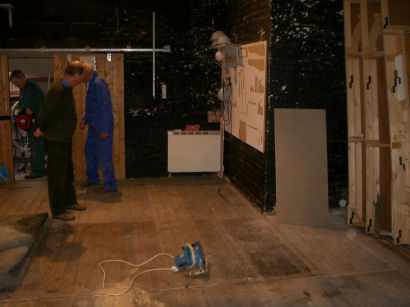The big project for this year was to replace the stage carpet and and fix some squeaks and “spongy” bits of the stage.
The carpet had been getting more and more threadbare in places and it was becoming increasingly difficult to hide the holes in it. As for the stage itself, it had recently become a major challenge for the stage manager, cast and crew to move about backstage without causing squeaks, rattles, movement of the flats, etc! Even on the front of the stage, actors had to move about gingerly if there were any glasses on tables or serving trays.
So, after postponing it last year, this summer we decided to replace the carpet and take a look at repairing any major problem areas with the stage structure. A fairly quick and simple job… so we thought!
With the old carpet up and gone it was time to look at the first squeaky area. For information, our stage is built up out of sections which comprise of a platform mounted on a framework.

Stage mostly cleared. The box roughly shows the size of the sections that form the stage

Our first suspicion is that the stage sections are rubbing against each other causing the squeaks, so we decide to cut a separation groove between two adjacent stage sections. It has no effect.

So, we look to prise up one of the planks that form the platform to see if we can isolate the problem. But once you start doing something like this…

…you end up with this! Yes, we ripped the whole thing apart. At this point it becomes evident that part of the problem is in the actual framework of the platforms. We have no choice but to rebuild this entire section.

Next we look at another stage section, so we begin lifting one out. The sections were surprisingly light in weight.

Once we get the section out and examine it, it becomes clear that we have a bit of a problem: The cross-bracing members supporting the planks appear to be split. They are remarkably thin pieces of timber really, and the trestle framework is not providing any support. This is clearly the cause of the “sponginess” of the stage, and we find this fault on pretty much the majority of the stage sections.

Here is a section upside-down. It transpires that these weren’t originally constructed in one go – the actual platform part was obtained by the theatre many, many years ago as a complete unit and we built the supporting framework. (Note: the short piece of timber running lengthways is not part of this section.)
With the advise and expertise of David Tinker, it is decided that we must do some quite major strengthening work to these sections to fix the problems. The plan is to add three runs of 3″x2″ timber lengthways, two down the inner sides (supporting the cross-members where they had spit) and one down the middle.

Here’s Stan, Frank and Lyndon working on the repairs.

And here is the finished article. The sections are slotted back into place (they’re much heavier now!) and padding pieces put underneath to adjust for level discrepancies.
One-by-one we checked the stage sections, and repaired them. The majority of the mid-stage sections needed to be done which took us several weeks to complete. Once the last section had been slotted back in to place, we planned the next step: carpeting.
When the new carpet goes down there will be no underlay, so to get a good level surface we’ve decided to cover the entire stage area with tongue-and-groove chipboard. As a precautionary measure against the stage sections possibly rubbing against each other and causing squeaks, we decide to separate the sections with a strip of plastic.

A strip of plastic (DPC course) is placed between the stage sections.

It is folded over and stapled down to prevent it moving once the chipboard goes down.
This was the state of play as of 3rd August. Next is laying down the chipboard and then carpeting:

We started laying the chipboard down from the stage left edge. All of the floor you see in this photo is chipboard.

Here is the last piece going in at stage right.

Another view of the stage with all the chipboard down and edging strips in place.
At this point the stage is looking pretty good. Squeaks and sponginess has all gone and we have a nice even surface ready for carpeting.
You may wonder why we carpet the stage. It is fairly unusual for theatres to have carpeted stage; normally the wooden flooring would just be painted black. However, because our theatre is fairly small, the noise of people walking about can easily be heard by our audience. This new flooring is remarkably quiet for someone walking about in soft shoes, however we asked some people to walk around the stage in hard-bottomed shoes and heels and there was a fair bit of noise generated. Hence carpeting.
So, we reach the final step of the project: carpeting. This was installed by a professional carpet fitter on Thursday 31st August.

Job done!
Thank you to all members of the society who helped out with this project.
